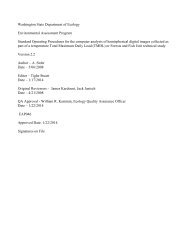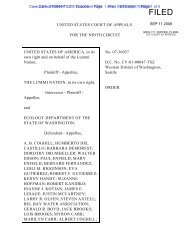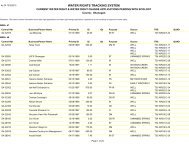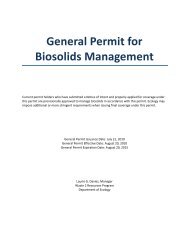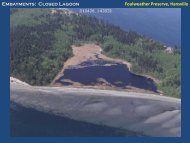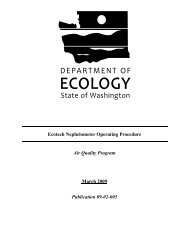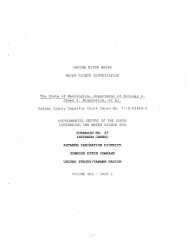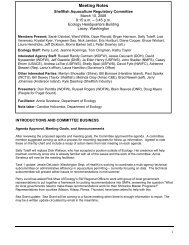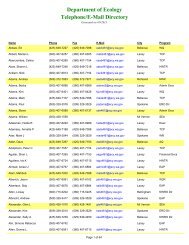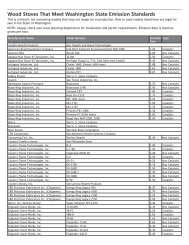WRIA 62 WMP 032305 - Washington State Department of Ecology
WRIA 62 WMP 032305 - Washington State Department of Ecology
WRIA 62 WMP 032305 - Washington State Department of Ecology
Create successful ePaper yourself
Turn your PDF publications into a flip-book with our unique Google optimized e-Paper software.
March, 2005 -48- 023-1289-003.3040<br />
<strong>WRIA</strong> <strong>62</strong> <strong>WMP</strong> <strong>032305</strong><br />
• Maximum hourly discharge change <strong>of</strong> 5,000 cfs.<br />
• Maximum change in average daily discharge <strong>of</strong> 10,000 cfs.<br />
As a component <strong>of</strong> the operation <strong>of</strong> Albeni Falls Dam there is an agreement between the <strong>State</strong> <strong>of</strong><br />
Idaho (represented by Idaho <strong>Department</strong> <strong>of</strong> Fish and Game) and the U.S. Government (represented by<br />
the ACOE) dated July 5, 1957 which provides for the loss or damage to wildlife resources. The<br />
agreement recognizes that unrestricted operation <strong>of</strong> Albeni Falls Dam would be detrimental to<br />
kokanee fry and states that the U.S Government will operate the project to avoid (where possible and<br />
maintaining consistency with the objective <strong>of</strong> power production) imposing operations which are<br />
unnecessarily detrimental to kokanee fry (ACOE, 2002). In response to public concern that the fall<br />
drawdown and pool fluctuations between November and March detrimentally impact kokanee<br />
spawning and egg incubation, Lake Pend Oreille drawdown and winter pool elevations were modified<br />
in 1967 and in the 1980s. These modifications resulted in the completion <strong>of</strong> the fall lake drawdown<br />
between November 15 and 20 to accommodate early spawning kokanee and establishment <strong>of</strong> a<br />
mandatory minimum control elevation from December 1 through March 31 to prevent dewatering <strong>of</strong><br />
kokanee eggs during their incubation.<br />
Lake drawdown tests to investigate the effect <strong>of</strong> higher winter lake levels on kokanee spawning were<br />
proposed in 1995 by Idaho <strong>Department</strong> <strong>of</strong> Fish and Game (IDF&G) and supported by the Northwest<br />
Power and Conservation Council (NPCC). In a letter dated December 9, 1995 to the NPCC, the<br />
ACOE indicated its intent to implement the test starting in the winter <strong>of</strong> 1996. The test schedule<br />
included three years <strong>of</strong> drawdown to 2,055 ft amsl and two years <strong>of</strong> drawdown to lower levels. The<br />
first three test seasons (with Lake elevations held at 2,055 ft amsl) were completed in the winters <strong>of</strong><br />
1996/1997, 1997/1998 and 1998/1999. However, the final two years, when the lake was originally<br />
scheduled to be held at 2,051 ft amsl over the winter, was challenged in court by the National Marine<br />
Fisheries Service (NMFS) and U.S. Fish and Wildlife Service (USFWS) due to concerns about the<br />
impact on bull trout in Lake Pend Oreille due to a possible collapse <strong>of</strong> the kokanee food source and<br />
the water supply for chum salmon in the lower Columbia. As a result <strong>of</strong> court actions and settlement<br />
agreements involving the ACOE, NMFS, USFWS, the Lake Pend Oreille Idaho Club and the Pend<br />
Oreille PUD, the lake was held at a compromise level <strong>of</strong> 2,053 ft amsl during the winters <strong>of</strong><br />
1999/2000 and 2000/2001 and at 2,051 ft amsl during the winter <strong>of</strong> 2001/2002. Following this, the<br />
lake has been held at 2,055 ft amsl and 2,051 ft amsl over the winters <strong>of</strong> 2002/2003 and 2003/2004,<br />
respectively.<br />
The ACOE acknowledges that Lake Pend Oreille drawdown is the major concern <strong>of</strong> those who<br />
believe that it has caused the decline in kokanee populations and has affected recreation, fishing,<br />
aesthetics, access and property values around the Lake (ACOE, 2002). The ACOE has disputed these<br />
claims on the basis that other factors (e.g., unrestricted sports and commercial fishing, imported<br />
mysid shrimp that compete with kokanee for food, reduced Lake water quality, upstream dam<br />
operations and predation on juvenile kokanee) may have contributed to the present problem. The<br />
ACOE also acknowledges the problems associated with managing the elevation <strong>of</strong> Lake Pend Oreille<br />
for competing needs and interests. The ACOE agrees that higher winter lake elevations have<br />
increased the outflow <strong>of</strong> water from Lake Pend Oreille earlier than normal in the spring. This<br />
increased earlier spring flow has coincided with the <strong>WRIA</strong> <strong>62</strong> run<strong>of</strong>f and has caused spring flooding<br />
<strong>of</strong> low lying land between Albeni Falls Dam and Box Canyon Dam. The ACOE is currently<br />
regulating Albeni Falls Dam in conformance with the original Congressional authorization and<br />
acknowledges that a major change in Lake drawdown may require Federal action.



